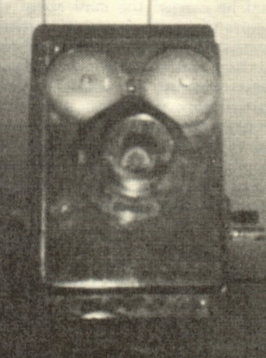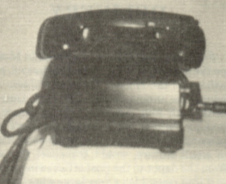TELEPHONES, OFFICES AND SWITCH BOARDS
by Claudia Tompkins
Entry T9 from the History of Hooker County Nebraska
with permission of the Hooker County Historical Society

Old 'Central Office' built in 1929-'30.

The improved wall phone (smaller).

The old wall phone.

The new desk phone '20's.

Current rotary dial phone before touch tone and
answering service phones.
The early telephones were quite a contrast
to the ones used today. They were just
beginning to come in frequently in the early
1900's. The radio was an advancement in
communications in the 1920's, then Tele-
vision after WWII. All of these means of news
and communication were added to the much
earlier newspaper and the telegraph. The
telephone has become so much a part of our
daily life that we hardly realize how much we
depend on it. Over the wires come all kinds
of news - sad, happy, sighs, laughter and
with all the tricks of speech by which we
distinguish one voice from another.
In the rural areas, at first, wire was strung
between two neighbors or more. Wire was
fastened to the fence posts and insulators
attached for carrying the signals to call the
neighbor to the phone. The early telephones
were those that hung on the wall with
batteries inside. An adjustable mouth piece
for the person's height, a handle to the right
side to ring the code and the ear piece hung
from a cord on the left. Each patron owning
a telephone had his own ring code, made up
of short and long rings. When the phone
would ring for a certain party (usually
everyone would take their phone off the hook
to listen in for any news or gossip, this was
called "rubbering") on what was called the
party line. Later these lines were extended to
the Mullen switch board where the operator
would put the call through to a different
phone line. Each neighborhood had to fur-
nish their own materials for building the
lines.
Charles F. and Margaret A. (Pool) Hicks,
after homesteading in south Cherry County,
moved to Mullen and operated a restaurant
business. They were the first telephone
operators in Mullen. Jimmy Hicks was the
operator in 1906.
A franchise was given to the Mullen
Telephone Company in May 1915, to operate
and conduct a telephone system in Mullen.
One long ring by turning the handle would
bring an answer "Number Please", 5 short
rings meant everyone should take their phone
off the hook and listen for the general
message being given, this might be reporting
a fire and come help, perhaps an accident, a
new baby announcement, a death or just
some general news. The telephone operator
is remembered as one of the most congenial
and helpful persons in the community,
delivering messages to those that had no
phone and maybe even giving out some
advice.
Myrtle Dutton Hood, daughter of Stuart L.
and Lalla Boyer Dutton, remembers the
"Central Office", located on the north side of
main street. Myrtle's Grandfather and Step-
Grandmother, Robert and Emma Alverda
Elliott Boyer "ran" the Central Office in
1914-1915. Grandma Boyer would allow
Myrtle to sit at the switchboard when the
family visited for Sunday supper. What a
thrill for a nine year old girl to face the
switchboard wearing an earphone, answering
calls by plugging in the correct pegs (there
were about ten) and turning the crank to ring
up the party. There were no lights on the
switchboards at this time. S.L. Dutton was
sheriff at the time and the telephone wires
were strung across the street east to the
Hooker County Tribune. The man the
Sheriff was chasing stopped in his tracks and
would not go under the wires which allowed
the pursuing sheriff to nab him.
The Mullen Telephone Company extended
their line southeasterly about 12 or 13 miles
of Mullen and 7 miles southwest of Seneca,
in April of 1918. They reached the ranch of
Tom E. Webber which is presently the Ranch
of Gaylord and Bonnie Porath.
In 1921, the Mullen folks were getting
interested in the Wireless telephone which
had been installed east of Brownlee for
receiving a daily bulletin of general news
service. The plan was originated by Post-
master General Hays, a plan to utilize the
larger radio stations of the mail service, each
about 400 miles apart. The local businessmen
discussed installing both a sending and
receiving station in Mullen. For entertain-
ment a company of neighbors might sit
within the home and enjoy a concert being
given in the City Park of San Francisco.
Mr. and Mrs. Figard were switch board
operators in Mullen and when they departed
for Silver Creek in 1927, Ernest Headrick
trucked his household goods from Thedford,
Nebraska and located in the Central Ex-
change building and was in charge of the
phone business. In the first 2 years of his
management an electric ringing machine was
attached to the switchboard, which did away
with many hours of `twist the wrist' during
the course of a day's work at "plugging holes".
He also replaced 39 phones within the city
limits and later many more patrons hooked
on.
The Mullen Central Phone Company
hooked up with San Pedro, California, Febru-
ary 1929 and carried on a 3 minute conversa-
tion. It took but 20 minutes to put the call
through. Mullen had reason to be proud of
their company.
The middle of April, 1929, the Bell Tele-
phone System had a crew of men putting in
additional circuits from Broken Bow to
Alliance, Nebraska. The dismantiling of the
old central office building (east of the
Historical House) was done in 1929. The new
building 22 feet X 40 feet was constructed by
F.T. Gier and Sons of Seneca. It was built on
the same site and still stands.
Through the years following Ernest Head-
ricks departure in 1937, Paul and Eva Long
were the Telephone operators at the switch
board. In 1942, E.G. Longs. Della Blivins,
near Brownlee owned the business and
building, when Jack and Nadyne Carlson
operated the switchboard. They lived in the
living quarters in the back of the building for
a number of years.
In 1942, Walter Barnebey and John Gillis-
pie, who were in the plumbing business,
started building a house for John and Esther
(the home that Howard and Virginia Huddle
now own). Walt and John also started the
building on 209 NW 1st Street, which is now
the B & D Enterprises. They finished the
building with living quarters in the back
where John and Esther lived till their own
home was finished. Florence stocked a style
shop and Walter in the meantime had
purchased the Telephone Business, which he
installed to the front of the building, where
Florence operated the switchboard and with
the help of Nadyne Carlson also kept the
style shop.
Walter sold the telephone business to Cliff
Thompson and the switchboard was moved
to the 2nd floor of the "Del" (now owned by
Floyd Long's) located on the east side of the
hall about 1946. J.E. Macke and wife Cecile
bought the previous building from the Barne-
bey's to remodel for a theatre. There were a
number of different switchboard operators
working over the "Dell" while the cement
building was getting in readiness for a central
telephone system which would do away with
a switchboard and a dialing system would be
installed. Eventually there were no more
party lines and each patron had a private line.
Later still, underground telephone cables
were laid to lessen the upkeep due to storms
and winds.
The Consolidated Telephone Company
has made great strides of advancement
through the years in Mullen, from the wall
phones to `touch tone' and answering service
phones. The local men that come to our `beck
and call' when our phones needed service and
still do are: Ellis Jacobs with 27 years of
service; Russell Evans with the company 14
years.
The telephone will be in active use as
Mullen and the surrounding area are prepar-
ing for the Centennial year in 1989.




